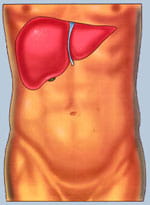The liver is the largest and perhaps the most complex organ in the body.
Your liver is made up of two main lobes, or sections, but that's just the beginning. There are many parts, all working together, that allow your liver to perform more than 300 functions.
Parts That Make Up The Liver
Lobules
The liver has two lobes — the right and the left.

- Each lobe is made up of thousands of hexagonally-shaped lobules. These lobules are very small.
- Each lobule is made up of numerous liver cells, called hepatocytes, that line up in radiating rows.
- Between each row are sinusoids. These small blood vessels diffuse oxygen and nutrients through their capillary walls into the liver cells.
The lobules are connected to small bile ducts that connect with larger ducts to ultimately form the hepatic duct.
Hepatic Duct
The hepatic duct transports bile, produced by the liver cells, to the gallbladder and duodenum (the first part of the small intestine).
The gallbladder, a separate organ that works closely with the liver, is attached to the bile duct. Although it's small, the gallbladder is distensible, which means it's able to stretch out (or distend) if necessary.
The gallbladder stores bile and releases it back into the duct on cues from the stomach.
Portal Vein and Hepatic Artery
At any given moment, the liver holds about 13 percent of the body's blood supply.
Your liver gets blood from two distinct sources: the portal vein and the hepatic artery.
Portal Vein
- The liver's primary blood source
- Carries nutrient-rich blood from the intestines to the liver
Hepatic Artery
- The liver's secondary blood source
- Delivers oxygen-rich blood from the heart to the liver
This is how the sinusoids get all that nutrient- and oxygen-rich blood.
Inferior Vena Cava
The inferior vena cava is a large main vein that carries blood through the liver and back to the heart.
- Blood leaves your liver through a central vein in each lobule, and then through a hepatic vein, one of several short veins originating within the lobes of the liver as small branches.
- These unite in a network of hepatic veins that lead directly to the inferior vena cava.
- The inferior vena cava collects blood from parts of the body below your diaphragm, and passes that blood on for your heart to use.
Other Organs: Gallbladder and Pancreas
The Gallbladder

Below the right lobe of the liver lies the gallbladder — a hollow, pear-shaped, saclike organ.
The gallbladder stores bile, a greenish brown fluid produced by the liver to help the body break down and use fats. When a person eats, the gallbladder empties bile into the intestines to help digest food.
The Pancreas

The pancreas, located below the liver and gallbladder:
- Produces enzymes that aid in digestion
- Makes insulin to balance blood sugar levels
- Releases needed hormones into the blood


















